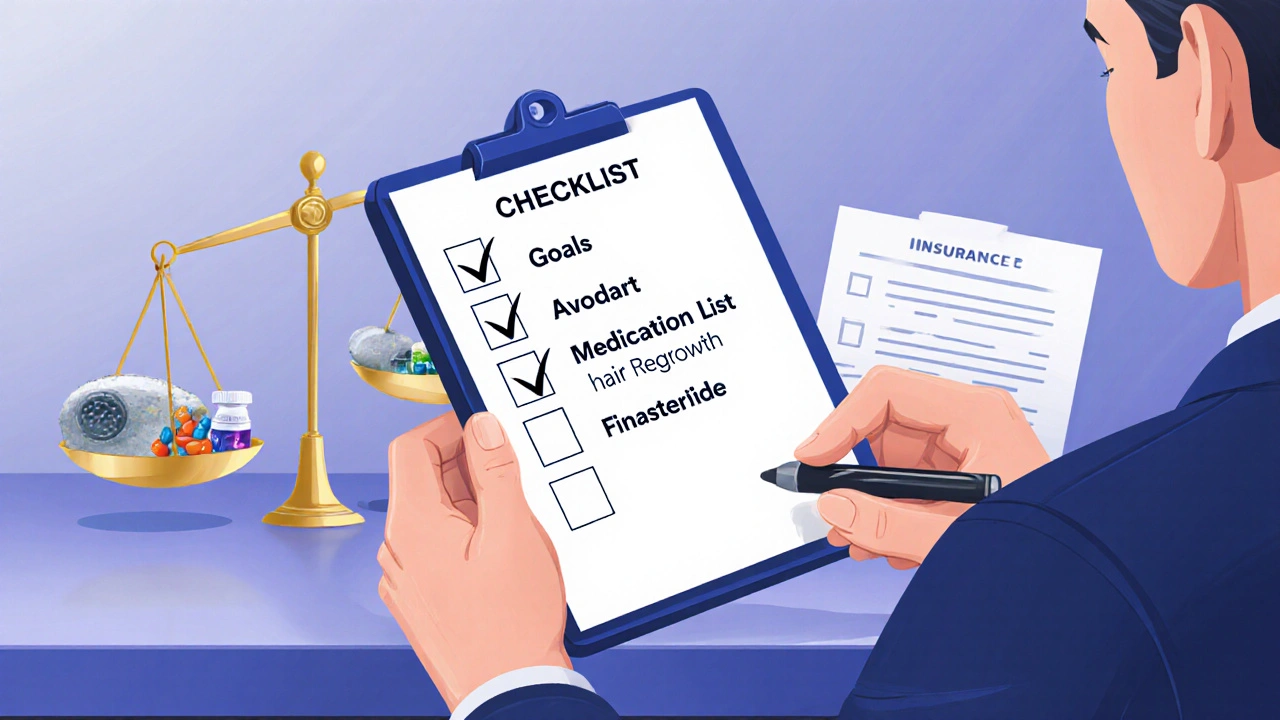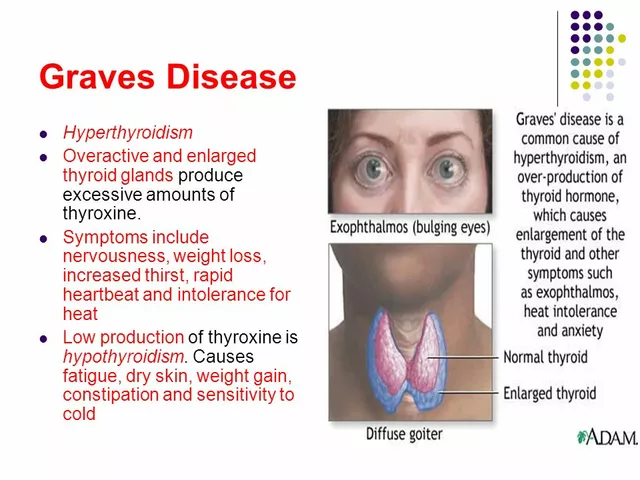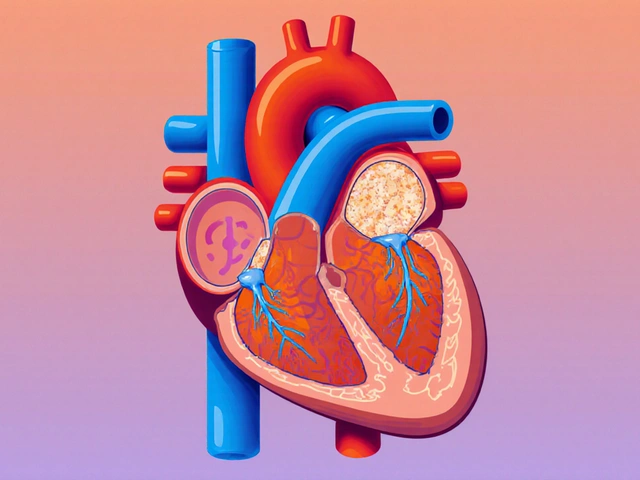When doctors talk about treating enlarged prostate or male‑pattern baldness, they often throw around the term “5‑alpha‑reductase inhibitor.” But the market is crowded: you have Avodart, a few finasteride brands, and a handful of herbal options. Picking the right one isn’t just about price - it’s about how each drug works, how quickly it shows results, and what side‑effects you might face.
Below you’ll find a step‑by‑step comparison that walks you through the most common alternatives, highlights the key decision factors, and gives you a practical checklist you can use at the next doctor’s visit.
Dutasteride is a synthetic, long‑acting 5‑alpha‑reductase inhibitor originally approved for benign prostatic hyperplasia (BPH). It is sold under the brand name Avodart and, off‑label, for androgenic alopecia. Avodart reduces dihydrotestosterone (DHT) by inhibiting both type 1 and type 2 isoforms of the enzyme, a broader action than most finasteride products.
Why the Comparison Matters
- Patients often switch between drugs after experiencing side‑effects or insufficient symptom relief.
- Insurance coverage varies dramatically across brands and over‑the‑counter supplements.
- Understanding the pharmacology helps you discuss realistic expectations with your urologist.
Key Comparison Criteria
- Mechanism of Action - which isoforms of 5‑alpha‑reductase are blocked?
- Efficacy - how much does the drug shrink the prostate or improve hair density?
- Dosage & Frequency - daily pill, weekly dose, or oral solution?
- Onset of Benefit - weeks, months, or longer?
- Side‑Effect Profile - sexual dysfunction, gynecomastia, mood changes, etc.
- Cost & Insurance Coverage - generic vs brand, out‑of‑pocket expense.
- Drug Interactions - CYP450 metabolism concerns.
Top Alternatives to Avodart
Below is a quick snapshot of the most frequently prescribed or discussed options.
| Drug / Supplement | Active Ingredient | Approved Uses | Mechanism | Typical Dose | Key Side‑Effects |
|---|---|---|---|---|---|
| Avodart | Dutasteride | BPH, off‑label hair loss | Inhibits type 1 & 2 5‑α‑reductase | 0.5 mg daily | Decreased libido, erectile dysfunction, breast tenderness |
| Proscar | Finasteride (5 mg) | BPH | Selectively blocks type 2 enzyme | 5 mg daily | Less frequent sexual side‑effects, rare depression |
| Propecia | Finasteride (1 mg) | Male‑pattern baldness | Selective type 2 inhibition | 1 mg daily | Similar sexual profile, occasional scalp irritation |
| Saw Palmetto | Extract of Serenoa repens | Benign prostate symptoms (OTC) | Weak, non‑specific 5‑α‑reductase inhibition | 320 mg daily (standardized) | GI upset, rare allergic reaction |
| Beta‑sitosterol | Plant sterol mixture | OTC BPH symptom relief | Competes with DHT at receptor level | 60-130 mg twice daily | Minor stool changes, occasional nausea |
Deep Dive: How Each Option Stacks Up
Mechanism of Action - Avodart’s dual‑isoform blockade gives it a 2‑ to 3‑fold greater DHT reduction compared with finasteride, which targets only type 2. This explains why Avodart often shows larger prostate volume reductions in clinical trials.
Efficacy for BPH - In a 24‑month study, Avodart decreased prostate size by an average of 25 % versus 18 % for finasteride. Men reported better urinary flow scores after 6 months on Avodart.
Hair‑Loss Results - For androgenic alopecia, both drugs lower scalp DHT, but Avodart’s broader inhibition can yield a 15‑20 % higher hair‑count increase after 12 months, according to a 2023 dermatology trial.
Onset of Benefit - Expect a 3‑month latency for urinary symptom relief with either drug. Hair growth improvements usually appear after 6‑9 months, regardless of brand.
Side‑Effect Profile - The main trade‑off is a slightly higher incidence of sexual dysfunction with Avodart (≈10 % vs 6 % for finasteride). Both classes can cause gynecomastia, though it remains under 2 % overall. Over‑the‑counter options (saw palmetto, beta‑sitosterol) have milder side‑effects but also weaker efficacy.
Cost Considerations - Generic finasteride (1 mg) costs about $0.15 per pill in the U.S., making it the most budget‑friendly choice. Avodart’s brand price averages $2.50 per 0.5 mg tablet, though some insurance plans cover it for BPH. Herbal supplements cost $0.30‑$0.50 per capsule but require consistent daily use.
Drug Interactions - Both dutasteride and finasteride are metabolised by CYP3A4. Caution with strong inhibitors (ketoconazole, clarithromycin) or inducers (rifampin). Herbal extracts have minimal CYP impact but can affect blood clotting if taken with anticoagulants.
Practical Checklist for Your Next Appointment
- Bring a list of current medications (prescription, OTC, supplements).
- Know your primary goal: prostate size reduction vs hair regrowth.
- Ask your doctor about baseline PSA and DHT levels - they help gauge drug response.
- Discuss any history of sexual dysfunction, mood disorders, or breast tenderness.
- Verify insurance coverage for brand‑name vs generic options.
- Set a realistic timeline: expect at least 3 months before judging effectiveness.
When to Choose Avodart Over Alternatives
If you need the strongest DHT suppression - for example, a large prostate (>40 g) or rapid hair‑loss progression - Avodart’s dual‑isoform action makes it the most potent choice. It’s also preferred when finasteride has failed to produce adequate symptom relief.

When a Simpler Option May Be Better
For mild BPH symptoms or a modest hair‑loss pattern, finasteride’s lower side‑effect rate and cheap price often outweigh the extra potency of Avodart. Patients who are especially sensitive to sexual changes may start with finasteride and only switch if necessary.
Those who prefer an over‑the‑counter route, or who have insurance barriers, can trial saw palmetto or beta‑sitosterol while monitoring symptom scores. Remember, the herbal path rarely shrinks the prostate by more than 10 %.
Frequently Asked Questions
Can I take Avodart and finasteride together?
Combining both does not provide additional DHT reduction and only raises the risk of side‑effects. Doctors usually pick one drug based on the needed potency.
How long does it take for Avodart to improve urinary flow?
Most men notice measurable improvement after 3‑4 months of daily dosing, though full benefits may continue up to a year.
Is Avodart safe for women?
Dutasteride is contraindicated in pregnant or breastfeeding women because it can affect a male fetus's genital development. It’s never prescribed to women for BPH or hair loss.
Do herbal alternatives interfere with other meds?
Saw palmetto can modestly affect CYP3A4 activity, so combining it with certain anticoagulants or hormone‑affecting drugs should be discussed with a pharmacist.
What should I monitor while on Avodart?
Track urinary symptoms (IPSS score), PSA levels every 6‑12 months, and any changes in libido or mood. Report persistent breast tenderness or severe erectile issues to your doctor promptly.
Bottom Line
Avodart offers the most comprehensive DHT suppression, making it the go‑to for severe BPH or fast‑progressing hair loss. Finasteride remains a solid, lower‑cost alternative with a milder side‑effect profile. Over‑the‑counter botanicals can help mild cases but won’t match prescription potency. By weighing efficacy, safety, and budget against your personal health goals, you can pick the right 5‑alpha‑reductase inhibitor for you.







Sarah Riley
October 22, 2025 AT 18:20